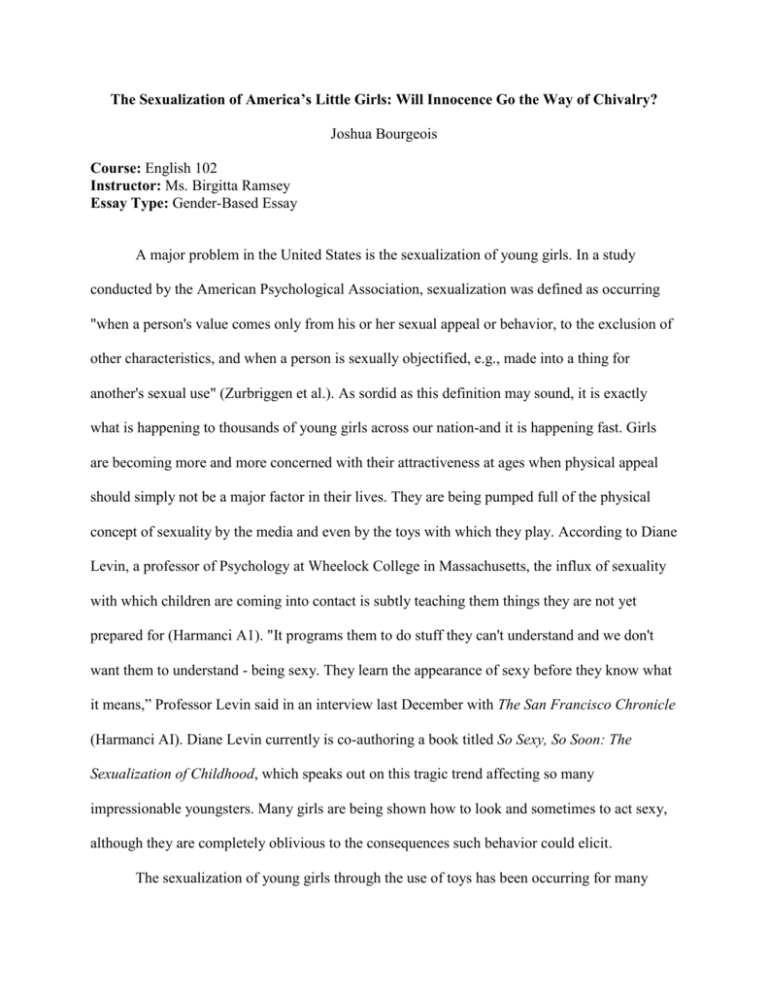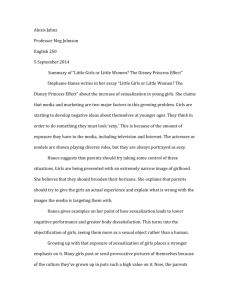The Sexualization of America's Little Girls: Will Innocence Go the
advertisement

The Sexualization of America’s Little Girls: Will Innocence Go the Way of Chivalry? Joshua Bourgeois Course: English 102 Instructor: Ms. Birgitta Ramsey Essay Type: Gender-Based Essay A major problem in the United States is the sexualization of young girls. In a study conducted by the American Psychological Association, sexualization was defined as occurring "when a person's value comes only from his or her sexual appeal or behavior, to the exclusion of other characteristics, and when a person is sexually objectified, e.g., made into a thing for another's sexual use" (Zurbriggen et al.). As sordid as this definition may sound, it is exactly what is happening to thousands of young girls across our nation-and it is happening fast. Girls are becoming more and more concerned with their attractiveness at ages when physical appeal should simply not be a major factor in their lives. They are being pumped full of the physical concept of sexuality by the media and even by the toys with which they play. According to Diane Levin, a professor of Psychology at Wheelock College in Massachusetts, the influx of sexuality with which children are coming into contact is subtly teaching them things they are not yet prepared for (Harmanci A1). "It programs them to do stuff they can't understand and we don't want them to understand - being sexy. They learn the appearance of sexy before they know what it means,” Professor Levin said in an interview last December with The San Francisco Chronicle (Harmanci AI). Diane Levin currently is co-authoring a book titled So Sexy, So Soon: The Sexualization of Childhood, which speaks out on this tragic trend affecting so many impressionable youngsters. Many girls are being shown how to look and sometimes to act sexy, although they are completely oblivious to the consequences such behavior could elicit. The sexualization of young girls through the use of toys has been occurring for many years. A prime example of such a toy is the world-renowned Barbie doll. Barbie was originally created in 1959 by Ruth Handler. It is unsettling to know that the Barbie doll of today was based on a German-made sex toy designed for adult men (Harmanci A1). Because the general public was unaware of Barbie's shadowy beginning, she gained popularity rapidly. Since that time, Barbie has been teaching an unfathomable amount of girls a particular lesson: being pretty is the main component in the attainment of happiness. With her slim waist and pronounced bosom, she served as a focal point for generations of young girls to view and model themselves after, thinking her to be the epitome of how successful and happy women looked. In 2001, a new and more stylish competitor arrived on the scene, the Bratz doll. These dolls, however, are not for the very young; they are favored by the so-called "tweens,” or those children who range in age from around eight to twelve. Whereas Barbie is a tall and somewhat busty figure, Bratz dolls tend to be slightly shorter with less pronounced bosoms. However, they compensate for this with generous amounts of eye makeup, lipstick-covered pouting lips, and, as Diane Levin puts it, an "eating-disordered body" (Harmanci A1). Just as Barbie established the definition of "pretty" for earlier generations of young girls, Bratz dolls are doing the same thing for a slightly older crowd. They are simply reinforcing an already in-place mindset: if you want to be happy, then you need to be pretty. The main problem with this is deciding who is responsible for maintaining a respectable definition of "pretty.” Considering the dolls play a large role in determining what the majority of girls see as pretty, then it should logically fall into the hands of the manufacturers to define beauty. The only problem is that toy producers are in the business of making a profit, and it is quite rare that making a profit and doing the right thing coincide. Even though many marketers know they are selling dolls such as Bratz with obvious sexual qualities, they cannot be blamed completely. After all, the company exists to make a profit, so it must market what is in demand. It is not the company's fault that what the youth of America want is not totally wholesome. For example, Chris Byrne, a toy industry expert, says, "Girls don't see Bratz as trampy; they just see pretty, as it's personified by Paris Hilton or any of the MTV videos. There's been a redefining of what pretty is" (Harmanci A1). So, the media are also partly to blame. It is a commonly known fact that many people-not only Americans-look up to those who live in the "limelight,” wanting to be just like them: successful, beautiful, and loved. While this may constitute nothing more than a harmless wish by a mature individual, children are more susceptible and believe if they emulate media icons, then they will receive all the aforementioned benefits. So, when a little girl sees a paper-thin, almost anorexic, model going down a runway and being met with thunderous applause, or a celebrity like Nicole Richie being surrounded by paparazzi while leaving rehab, she associates these glamorous stars with being pretty and happy. It is a truly sad thought that this is the kind of message so many young children are embracing. Ultimately, the future innocence of multitudes of America's little girls is in danger. Our youth are constantly bombarded by what society wants them to perceive as pretty while simultaneously being taught to objectify themselves. Unless something is done soon, this sexualization of young girls will only continue and possibly even get worse. A sex educator from Maryland, Deborah Roffman, put it best when she said: Kids have always emulated adult things. But [years ago] it was, 'That's who I'm supposed to be as an adult.’ It's very different today. The message to children is, 'You're already like an adult. It's okay for you to be interested in sex. It's okay for you to dress and act sexy, right now'. (ctd in Weiner F0l) It is truly disconcerting that a message such as this exists in our national culture. Unless something is done, and hopefully done soon, the innocence of many young American girls may not have any chance at survival. Works Cited Harmanci, Reyhan. "Innuendo Over the Punch Bowl, Under the Tree 'CULTURAL SHIFT: Little Girls, Sexy Dolls - Toy Industry Markets to Kids Growing Older Younger.’” The San Francisco Chronicle 17 Dee. 2006, final ed.: Al Weiner, Stacy. "Goodbye to Girlhood: 'As Pop Culture Targets Ever Younger Girls, Psychologists Worry About a Premature Focus on Sex and Appearance.’” The Washington Post 20 Feb. 2007, final ed.: F01 Zurbriggen, Eileen L., et al. Report of the APA Task Force on the Sexualization of Girls. Washington: American Psychological Association, 2007. Ms. Ramsey’s Comments: I found Joshua’s essay both intriguing and interesting.





